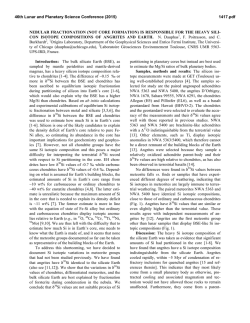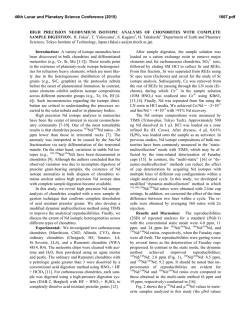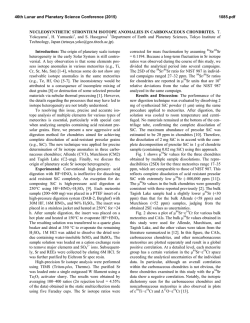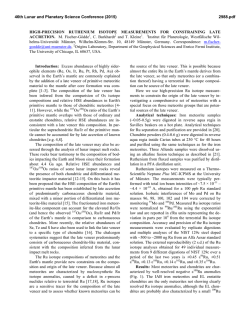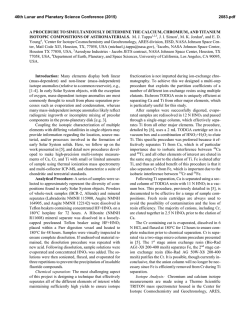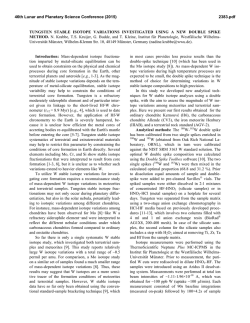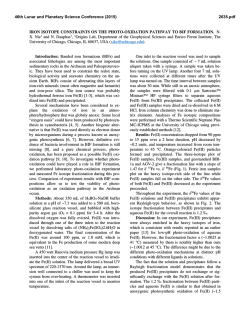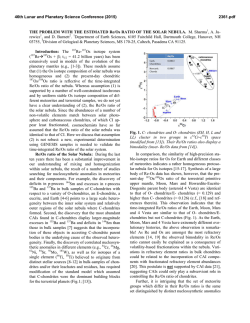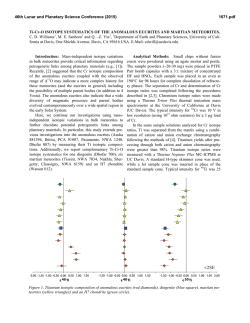
CHROMIUM STABLE ISOTOPE COMPOSITION OF METEORITES. L
46th Lunar and Planetary Science Conference (2015) 2015.pdf CHROMIUM STABLE ISOTOPE COMPOSITION OF METEORITES. L. Qin1, J. Xia1,2,3, R. W. Carlson2 and Q. Zhang1. 1CAS Key Laboratory of Crust-Mantle Materials and Environment, University of Science and Technology of China, 96 Jinzhai RD., Hefei, Anhui 230026, China; 2 Department of Terrestrial Magnetism and 3 Geophysical Laboratory, Carnegie Institution of Washington, Washington, DC 20015, USA. (E-mail: [email protected]) Introduction: Chondrites are often used as reference materials for studying the chemical and isotopic composition of the Earth. Differences in the stable isotope composition of elements between meteorites and the bulk-silicate Earth (BSE) have been used for tracing planetary processes, such as silicate-metal differentiation and volatility [1-6]. For example, the differences in Si isotope compositions between chondrites and the BSE have been used as evidence for segregation of Si into the core, and subsequent the reduction of Si/Mg ratio in the BSE [4-6]. A recent study found that chondrites have systematically lower δ53Cr values (up to 0.2 ‰) than the BSE [7]. This was interpreted by the authors to reflect incorporation of isotopically light Cr into the core at relatively low temperatures and high oxygen fugacities (in order to have large isotope fractionation between the metal and silicates). Incorporating Cr into the core can also explain the negative deviation of Cr abundance in the mantle from the terrestrial volatility trend. However to cause the observed amount of Cr isotope fractionation requires a significant amount of Cr being partitioned into the core, which could be limited at high oxygen fugacities [7]. In addition, one of the consequences of large mass fractionation between chondrites and terrestrial samples is that it could potentially affect the accuracy of the measured non-mass dependent effects on 53Cr/52Cr and 54Cr/52Cr [8]. This is because the mass-dependent fractionation in nature does not follow an exponential mass dependence. When Cr is corrected for instrumental mass fractionation assuming an exponential mass dependence for the fractionation, if there is a significant offset between different samples in their 50 Cr/52Cr ratio caused by natural mass fractionation, use of the exponential law will create what appear to be offsets in both 53Cr/52Cr and 54Cr/52Cr. Most of the Cr stable isotope analyses of meteorites have been obtained with MC-ICP-MS using only standard-sample comparison, not double-spiking [7, 9]. The accuracy of this technique largely relies on a very high Cr recovery rate from the chemistry, minimization of molecular isobaric interferences (e.g. ArN+, ArO+, and ArC+) on Cr isotopes, and efficient removal of organic matter dissolved from the resin. Adding a Cr isotope double-spike to monitor and correct for potential mass fractionation caused by the chemical purification procedures and during instrumental analysis has been used to great success in the analysis of Cr stable isotope variation in terrestrial samples [e.g. 10]. In this work, we seek to minimize potential analytical artifacts on Cr stable isotope measurements of meteorites by combining the 50Cr-54Cr double-spike technique and thermal ionization mass spectrometry (TIMS). Methods: Analytical procedures The studied chondrites were previously fused with lithium borates at 1050~1100 °C and subsequently dissolved in 2 N HNO3 to ensure complete sample digestion. These solutions were used for the analyses of massindependent Cr isotope effects reported previously [8]. The sample solution containing 1 µg Cr was mixed with an appropriate amount of 50Cr-54Cr double-spike before it was processed through a three-step column purification procedure [8]. Purified Cr was loaded on Re filaments with silica gel and saturated boric acid and analyzed with a Thermo Finnegan Triton TIMS at DTM following the procedure described in [8], except that each spiked sample was only analyzed once. Within each analytical session, a double-spiked NIST SRM 979 standard was loaded on two filaments and was run at least three times. The resulting 2 standard deviation for these standard measurements is usually 0.02 ~ 0.03‰ on δ53Cr. The internal errors (2s.e.) for individual sample analyses were usually slightly larger than this (0.02 ~ 0.06‰). The long-term reproducibility of NIST SRM 979 standard over a period of one year is 0.035‰. Data processing Both the unspiked Cr isotope ratios obtained in our previous study [8] and the spiked ratios in this study were used to calculate the absolute Cr isotope abundances, from which radiogenic effects on 53Cr/52Cr were subsequently subtracted to calculate mass-dependent isotope effects on 53Cr/52Cr. The reported Cr isotope data (δ53Cr, relative deviation of 53 Cr/52Cr in the sample from the standard times 1000) thus soley reflect the mass-dependent isotope effects. Because the radiogenic contribution is less than 0.03 ‰ for chondrites, the resulting radiogenic correction on δ53Cr is usually less than 0.05 ‰. Eucrites are usually more radiogenic than chondrites, thus larger radiogenic corrections were applied to these samples. Results and Discussions: All chondrites studied here have δ53Cr values in the range of -0.18 ± 0.04 to 0.02 ± 0.04 ‰ (Fig. 1). These are within the range (~ 0.2 to 0 ‰) observed for mantle-derived rocks from 46th Lunar and Planetary Science Conference (2015) various mantle reservoirs (grey area, Fig. 1). Compared to carbonaceous and ordinary chondrites, enstatite chondrites show slightly higher δ53Cr values, but not resolvably so within the analytical uncertainty. This offset could reflect the oxidation states present when the metal was formed, but this idea remains to be tested.. Eucrites/diogenites have more negative δ53Cr values than chondrites and mantle-derived rocks. The δ53Cr values of eucrites/diogenites roughly correlate with the MgO contents, and thus might reflect crystallization of pyroxene, as Cr is incompatible in olivine. Although only a limited number of samples from each mantle reservoir have been studied so far, our new chondrite Cr isotope data suggest that there is no systematic difference between chondrites and mantlederived rocks, whereas previous studies have suggested that chondrites have systematically lighter Cr [7, 9]. Thus the new data do not require fractionation of Cr stable isotope composition during core formation, which could suggest either a very high-temperature of core formation where isotope fractionation is minimized, that metal-silicate separation does not strongly fractionate Cr isotopically, or that too little Cr was incorporated into the core to cause mantle Cr to reflect significant isotope mass fractionation. Fig. 1. Cr stable isotopic composition of chondrites. Grey band encompasses the range in Cr isotope composition measured for mantle-derived rocks from Earth [11]. Conclusions: Chondrites show δ53Cr values in the range of -0.18 to -0.02 ‰ relative to the NIST SRM 979 standard (Fig. 1). Enstatite chondrites may have slightly heavier Cr isotope compositions than carbonaceous and ordinary chondrites, possibly reflecting the oxidation states during which metal forms. The δ53Cr values of eucrites/diogenites shift to slightly negative values compared to chondrites and mantle-derived rocks. The rough correlation between δ53Cr and MgO of eucrites/diogenites may reflect crystallization of pyroxene. The new δ53Cr values of chondrites are very 2015.pdf similar to the range observed for mantle-derived rocks. Our new results suggest that either only limited amounts of Cr partitioned into the core or that at the P, T conditions of mantle-core differentiation, no Cr isotope fractionation took place between the two reservoirs. References: [1] Poitrasson F. et al. (2004) EPSL, 223, 253-266. [2] Poitrasson F. et al. (2005) EPSL, 234, 151-164. [3] Regelous M. et al. (2008) EPSL, 272, 330-338. [4] Shahar A. et al. (2009) GCA, 75, 7688-7697. [5] Fitoussi C. et al. (2009) EPSL, 287, 7785. [6] Chakrabarti R. et al. (2010) GCA, 74, 69216933. [7] Moynier F. et al. (2011) Science, 331, 14171420. [8] Qin L. et al. (2010) GCA, 74, 1122-1145. [9] Schiller M. et al. (2014) JAAS, 29, 1406-1416. [10] Ellis A. S. (2002) Science, 295, 2060-2062. [11] Schoenberg R. et al. Chem. Geol., 249, 294-306. [12] Farkaš J. et al. (2013) GCA,123, 74-92.
© Copyright 2026
